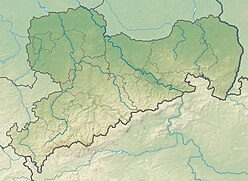Fichtelberg (Erzgebirge)
| Fichtelberg | |
|---|---|
 |
|
| Highest point | |
| Elevation | 1,214.6 m (3,985 ft) |
| Coordinates | 50°25′43″N 12°57′17″E / 50.42861°N 12.95472°ECoordinates: 50°25′43″N 12°57′17″E / 50.42861°N 12.95472°E |
| Geography | |
| Location | Saxony, Germany |
| Parent range | Ore Mountains |
The Fichtelberg (German pronunciation: [ˈfɪçtəlbɛɐ̯k]) is a mountain with two main peaks in the middle of the Ore Mountains in the east German state of Saxony, near the Czech border. At 1,214.6 m (3,985 ft) above sea level, the Fichtelberg is the highest mountain in Saxony, the second highest in the Ore Mountains and used to be the highest mountain in East Germany. Its subpeak is 1,206 m (3,957 ft) high.
The Fichtelberg rises within the Central Ore Mountains in the Ore Mountains/Vogtland Nature Park around 1.5 kilometres north of the German-Czech border. At the southern foot of the mountain lies the highest town in Germany: the resort of Oberwiesenthal in the Pöhlbach valley. About 750 metres south-southwest is the less prominent subpeak of the Fichtelberg, known as the Kleiner Fichtelberg ("Little Fichtelberg") also called the Hinterer Fichtelberg ("Rear Fichtelberg"); 1,205.6 m). About 4 kilometres south-southeast is the highest peak in the Ore Mountains: the Klínovec (Keilberg; 1,244 m) on the Czech side of the border. In the wet valley heads and raised bogs on the Fichtelberg, numerous streams have their sources. The most important of these is the River Zschopau.
The Fichtelberg consists predominantly of light-coloured, crystalline rocks, especially a variety of muscovite slate (Muskovitschiefer). In the main, this rock only comprises quartz and muscovite; although it sometimes contains orthoclase and biotite as well. Additional components include rutile, garnet, tourmaline, hematite and ilmenite.
...
Wikipedia

